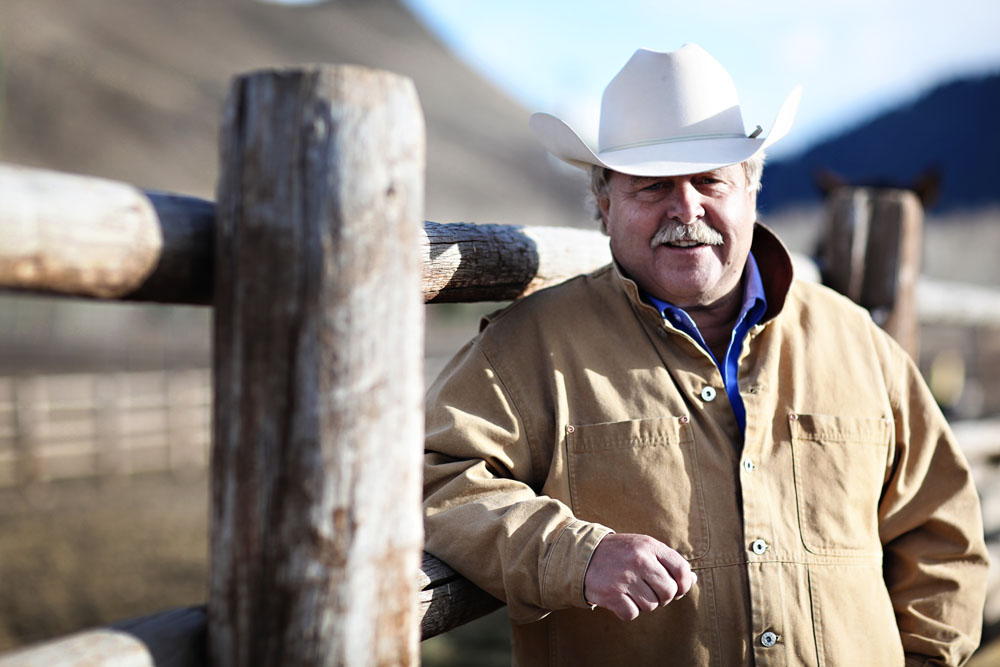“Taking a picture is telling a story,” explained renowned Western photographer David Stoecklein, while sitting in his Ketchum gallery surrounded by longhorn skulls, woven riding blankets and leather saddles. “I’m trying to communicate a story in every photo I take.”
Although Stoecklein grew up in Pennsylvania and his work became famous in the 1980s through an impressive client list that included Coca-Cola, Reebok and Chevrolet, his lens was eventually drawn westward. “I always wanted to be a ski bum, so I brought my camera with me and moved west to ski,” he said.
A self-taught photographer, Stoecklein shot skiing photos around the slopes of California and Utah until finally settling in Sun Valley with his wife Mary in 1979. Local ranchers and fishermen like Jack Goddard and Ray and Mike Seal (who, coincidentally, became his first unwitting models) introduced him to “the Idaho life.”
“You can’t be a great photographer, or a specialist like I am, unless you do the activity you’re photographing. In other words, you can’t be a ski photographer if you’re not a skier,” Stoecklein said, which is how he got involved with ranching. He owns a working ranch near Mackay, Idaho, splitting his time between the Lost River Valley and his home in Sun Valley.
“It was sort of a relief for me to come here after the high-pressure world I was living in, and take pictures of Idaho and cowboys. It was the reality of working with people that are from the land, that work with the land. It was so relaxing to photograph people just doing what they do,” he said.
Captivated by the “spirit of the West,” and particularly by those stoic and lonesome figures gazing toward horizons that are so often at the center of his work, Stoecklein said he recognized not only a niche but a mission.
“It has been my goal for the last 30 years to completely document the West—to preserve it through my photography,” he said. Toward that end, he has produced over 50 books throughout his career.
To truthfully capture the “story” of the cowboy, Stoecklein said it was very important to first study and understand his subject—to gain their respect and trust. “I make an effort to know what the people are about, to understand their personalities and show them the way they’d like to be shown. Unless you know the subject, you won’t get them to open up to you,” he said. “That’s very important.”
That is why Stoecklein is able to reveal a cowboy’s soul in ways other photographers can’t, in one sideways glance or taut profile, in one calloused and cracking hand. It’s also why he has been hailed as one of the best photographers in the West, recognized with awards and an ever-growing list of clients like Stetson and Marlboro. Stoecklein is highly acclaimed for not only capturing the identity of an entire culture, but also for capturing a very important slice of American history.
“The West is uniquely American,” said Stoecklein. “And I want to show what it was like while I was alive,” because it’s a story that “deserves to be remembered.”
Two of his three sons, Drew, Taylor and Colby, have followed in their father’s footsteps, photographing the West as they live and see it today, carrying on their father’s tradition of storytelling.
“The stories that I tell are the same stories that have been told since the beginning of time,” said Stoecklein. “There is a famous photo of mine of a guy with a lantern and a calf, which is just the story of the shepherd taking care of his flock, and that goes back before Christ. Many people have told it before—it’s just how I interpret and tell that story differently each day. And after 43 years, I still can’t wait for the next photo shoot.”


